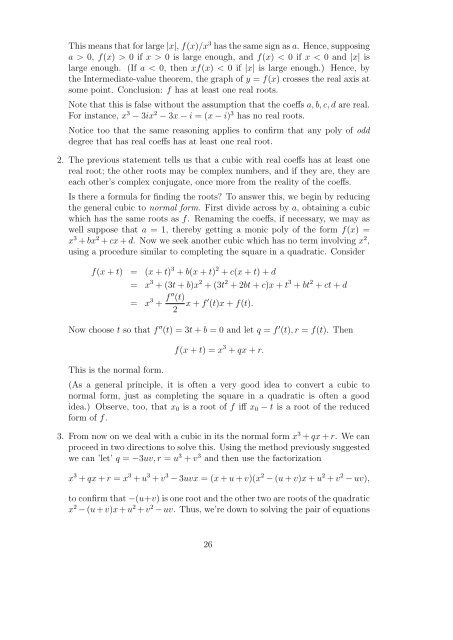Complex numbers and polynomials - University College Cork
Complex numbers and polynomials - University College Cork
Complex numbers and polynomials - University College Cork
You also want an ePaper? Increase the reach of your titles
YUMPU automatically turns print PDFs into web optimized ePapers that Google loves.
This means that for large |x|, f(x)/x 3 has the same sign as a. Hence, supposinga > 0, f(x) > 0 if x > 0 is large enough, <strong>and</strong> f(x) < 0 if x < 0 <strong>and</strong> |x| islarge enough. (If a < 0, then xf(x) < 0 if |x| is large enough.) Hence, bythe Intermediate-value theorem, the graph of y = f(x) crosses the real axis atsome point. Conclusion: f has at least one real roots.Note that this is false without the assumption that the coeffs a, b, c, d are real.For instance, x 3 − 3ix 2 − 3x − i = (x − i) 3 has no real roots.Notice too that the same reasoning applies to confirm that any poly of odddegree that has real coeffs has at least one real root.2. The previous statement tells us that a cubic with real coeffs has at least onereal root; the other roots may be complex <strong>numbers</strong>, <strong>and</strong> if they are, they areeach other’s complex conjugate, once more from the reality of the coeffs.Is there a formula for finding the roots? To answer this, we begin by reducingthe general cubic to normal form. First divide across by a, obtaining a cubicwhich has the same roots as f. Renaming the coeffs, if necessary, we may aswell suppose that a = 1, thereby getting a monic poly of the form f(x) =x 3 + bx 2 + cx + d. Now we seek another cubic which has no term involving x 2 ,using a procedure similar to completing the square in a quadratic. Considerf(x + t) = (x + t) 3 + b(x + t) 2 + c(x + t) + d= x 3 + (3t + b)x 2 + (3t 2 + 2bt + c)x + t 3 + bt 2 + ct + d= x 3 + f ′′ (t)2 x + f ′ (t)x + f(t).Now choose t so that f ′′ (t) = 3t + b = 0 <strong>and</strong> let q = f ′ (t), r = f(t). ThenThis is the normal form.f(x + t) = x 3 + qx + r.(As a general principle, it is often a very good idea to convert a cubic tonormal form, just as completing the square in a quadratic is often a goodidea.) Observe, too, that x 0 is a root of f iff x 0 − t is a root of the reducedform of f.3. From now on we deal with a cubic in its the normal form x 3 + qx + r. We canproceed in two directions to solve this. Using the method previously suggestedwe can ’let’ q = −3uv, r = u 3 + v 3 <strong>and</strong> then use the factorizationx 3 + qx + r = x 3 + u 3 + v 3 − 3uvx = (x + u + v)(x 2 − (u + v)x + u 2 + v 2 − uv),to confirm that −(u+v) is one root <strong>and</strong> the other two are roots of the quadraticx 2 − (u + v)x + u 2 + v 2 − uv. Thus, we’re down to solving the pair of equations26
















